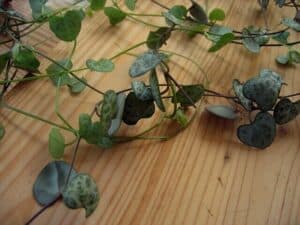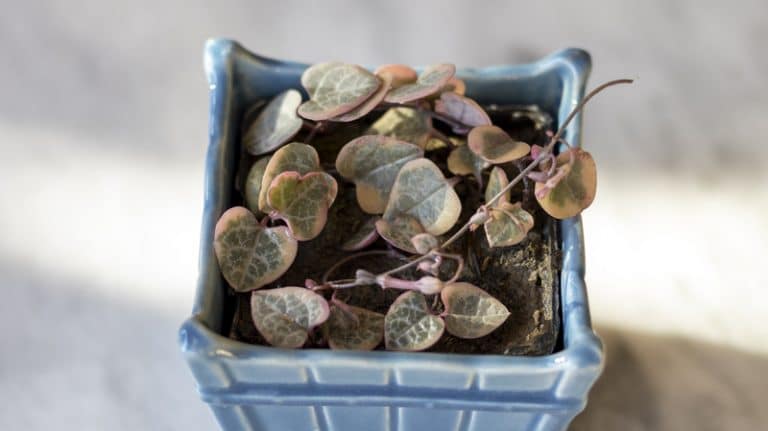String Of Hearts Dying
If you are an avid gardener, you know the feeling of heartbreak that comes when your beloved plants start dying. String of hearts (Ceropegia woodii), a popular indoor plant, is no exception. In this article, we will discuss the reasons why your string of hearts may be dying and what steps you can take to revive it.
Pain Points of String of Hearts Dying
You may have invested time, money, and effort in growing your string of hearts, only to find it wilting and dying. Losing a plant can be particularly distressing for those who consider themselves plant parents. Not knowing what causes the plant to die adds to the frustration and feelings of helplessness.
Why is My String of Hearts Dying?
Several reasons can contribute to the withering and wilting of string of hearts:
- Underwatering: As with most plants, underwatering is a common cause of string of hearts dying. The plant prefers to be watered thoroughly but the soil should be allowed to dry partially in between waterings.
- Overwatering: Overwatering can cause root rot, which is lethal to the plant. The soil should not be waterlogged, and excess water should be drained out of the pot.
- Insufficient Light: String of hearts thrives in bright, indirect light. Inadequate light can cause the plant to become leggy and wilt.
- Pest Infestation: Spider mites and mealybugs can infect the plant and weaken it from within. Signs of pest infestation include yellowing and curling of leaves.
Summary of Main Points
In summary, string of hearts can die due to underwatering, overwatering, insufficient light, or pest infestation. To revive your string of hearts, you need to address these issues. Read on to learn more about each reason and how you can prevent them from killing your plant.
Underwatering of String of Hearts
Underwatering is a common issue that causes string of hearts to shrivel and drop leaves. Some signs of underwatering include:
- Shrinking leaves that lose their plumpness
- Dry, brown patches on the leaves
- Slow growth
To address underwatering, you need to water the plant thoroughly until water runs out of the pot's drainage holes. However, allow the soil to dry partially before the next watering. Stick your finger into the soil to assess whether it is moist or dry. If it feels dry up to the first knuckle, it is time to water the plant.

Overwatering of String of Hearts
If you notice droopy, yellowing leaves that fall off quickly, it could be a sign of overwatering. Overwatering can cause root rot, which can quickly kill the plant.
To prevent overwatering, make sure the pot has good drainage and the soil is well-draining. Water the plant only when the top inch of soil is dry.

Insufficient Light
String of hearts needs bright, indirect light to grow well. If the plant doesn't receive enough light, it can start to wilt and drop leaves.
One way to ensure that your plant receives enough light is to place it near a window that receives bright, indirect light. Alternatively, you can use artificial grow lights to supplement natural light.

Pest Infestation
Spider mites and mealybugs can infest string of hearts and cause yellowing, curling leaves. These pests feed on the plant's sap, weakening and eventually killing it.
To prevent pest infestation, inspect your plant regularly and remove any insects you find. You may also use insecticidal soap or neem oil to control pests.

Question and Answer
Q: How often should I water my string of hearts plant?
A: Water the plant when the top inch of soil is dry to the touch. Stick your finger into the soil to assess its moisture content. Be sure not to overwater the plant, as this can cause root rot.
Q: Can I propagate my dying string of hearts plant?
A: Yes, you can propagate string of hearts by taking cuttings from a healthy plant and rooting it in water or soil. This can help you preserve your plant's genetics and have a second chance at growing a healthy plant.
Q: Does string of hearts need fertilization?
A: Yes, string of hearts needs occasional fertilization to thrive. Use a balanced houseplant fertilizer once a month during the growing season to provide the plant with essential nutrients.
Q: Can I grow string of hearts outdoors?
A: String of hearts is a tropical plant that prefers warm temperatures and high humidity. If you live in a warm, humid climate, you can grow string of hearts outdoors in a shaded area. However, if you live in a cooler climate, it's best to grow the plant indoors.
Conclusion
If you're experiencing the unfortunate situation of a dying string of hearts, don't fret. There are a variety of reasons as to why your plant is facing this difficult time, and simple, strategic steps you can take to revive it. Be conscious of its watering needs, ensure the amount of light and temperature are adequate, watch out for pests, and when possible, propagate a new plant. Following these helpful tips can help you to strengthen your string of hearts plant and ensure it thrives and lives long, giving you the enjoyment and satisfaction of owning a beautiful, healthy plant.
Gallery
Help! Why Are My String Of Hearts Looking Shriveled. Watered Them About

Photo Credit by: bing.com / dying shriveled facing watered worried ago
Underwatered String Of Hearts - How To Save It From Dying(Fix)

Photo Credit by: bing.com / underwatered
4 Reasons Why String Of Hearts Dying - Farmer Grows

Photo Credit by: bing.com /
String Of Hearts Dying? Revive String Of Hearts Plant – Gardener Report

Photo Credit by: bing.com /
String Of Hearts Is Dying, Help! Info In Comments : Plantclinic

Photo Credit by: bing.com /